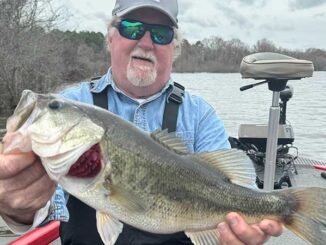
Perhaps the nation’s No. 1 gamefish, they’re available almost everywhere
Largemouth bass, Micropterus salmoides, are one of the most-important gamefish in the United States. Aside from numerous professional fishing tournament trails, as well as smaller semi-pro and amateur trails, countless Americans spend a great deal of time and money trying to catch these fish.
One reason they are so sought-after is their existence in such a wide variety of water types. Bass live in slow-moving streams, calm pools of large rivers, natural lakes and man-made lakes and ponds. They can tolerate brackish water, various levels of water quality and a wide range of water temperatures.
Largemouth bass, one of several black bass that live throughout the South, are members of the sunfish family. Unlike most sunfish, black bass have elongated bodies. They can be distinguished from their cousins, smallmouth bass and spotted bass, by their longer jaws, which extends past the rear corner of the eye when the fish’s mouth is closed.
These fish have one long dorsal fin which is so deeply notched that it looks like two different sections. Largemouth bass usually appear dark green to olive on the upper part of their body, while the lower part and belly are usually white or a very light green. In some bodies of water, however, these fish can look very dark green, almost solid black.
Largemouth bass have a lateral line that runs almost the entire length of its body. They almost always have a visible series of dark blotches on each side. These blotches merge with the lateral line. That lateral line provides a great deal of information to these fish as it picks up vibrations and movement.

Geographic kin
Two different strains of largemouth bass live throughout the South. The northern strain, despite its geographically deceptive name, is native to the southern states across the country. The Florida strain, native only to Florida, has been introduced throughout the South. The Florida strain grows bigger and more quickly, but they are less aggressive than the northern strain.
Bass buffet lines
Largemouth bass eat just about anything. As fry, they eat zooplankton and insects. Pretty soon, they begin eating bigger insects, then fish larvae. Once big enough, they begin eating other fish. As adults, other fish make up the majority of their diet. But largemouth will also eat worms, insects, birds, mice, and snakes. In brackish water, they often eat shrimp and small crabs. They are very opportunistic feeders. This is one reason for the huge amount of lure types available for catching largemouth bass.
These fish begin spawning when water temperatures range between 65o and 75o F. Throughout the South, this can occur as early as February, but typical spawning months are March through June.
Males construct saucer-shaped nests in water ranging from 2 to 10 feet deep. Females deposit between 5,000 to 150,000 eggs over the nest, then, the males fertilize the eggs. Eggs hatch in three or four days. Adult male bass guard the fry for several weeks. When independent enough, the young bass disperse.
Target structure
Largemouth bass prefer to stick close to structure or cover of some type. Sunken trees, docks, concrete walls, deep holes, and any type of sunken debris are prime spots for bass to hang out. In farm ponds with no structure, they usually seek out the deepest holes or stay close to the banks. They are skilled predators and are often the dominant gamefish in whatever body of water they live.
Nicknames for largemouth bass include green trout, bucketmouth, lunker, hog, and cypress trout.
The Louisiana state record largemouth bass came from Caney Lake in February 1994. Greg Wiggins caught the fish, which weighed 15.97 pounds.
Anthony Denny of Washington, Miss., caught the Mississippi state-record largemouth, an 18.15-pound fish. Denny’s prize catch occurred in Natchez State Park Lake in December 1992.
The world record largemouth bass is a tie, according to the International Game Fish Association (IGFA). George Perry’s 22.4-pound bass from Montgomery Lake, Ga., stood as the record for decades after being caught in 1932. In 2009, Manabu Kurita caught a 22.5-pound bass in Lake Biwa, Japan. According to the IGFA, a fish must weigh at least two ounces more than the previous world record to become the new record. Otherwise, it is considered a tie. Therefore, the IGFA lists Kurita and Perry as tied for the world-record largemouth bass.


